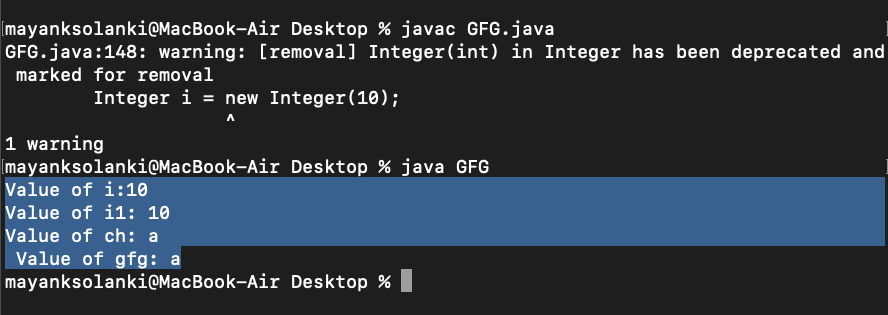Autoboxing and Unboxing in Java
Last Updated :
20 Apr, 2022
In Java, primitive data types are treated differently so do there comes the introduction of wrapper classes where two components play a role namely Autoboxing and Unboxing. Autoboxing refers to the conversion of a primitive value into an object of the corresponding wrapper class is called autoboxing. For example, converting int to Integer class. The Java compiler applies autoboxing when a primitive value is:
- Passed as a parameter to a method that expects an object of the corresponding wrapper class.
- Assigned to a variable of the corresponding wrapper class.
Unboxing on the other hand refers to converting an object of a wrapper type to its corresponding primitive value. For example conversion of Integer to int. The Java compiler applies to unbox when an object of a wrapper class is:
- Passed as a parameter to a method that expects a value of the corresponding primitive type.
- Assigned to a variable of the corresponding primitive type.
| Primitive Type |
Wrapper Class |
| boolean |
Boolean |
| byte |
Byte |
| char |
Character |
| float |
Float |
| int |
Integer |
| long |
Long |
| short |
Short |
| double |
Double |
The following table lists the primitive types and their corresponding wrapper classes, which are used by the Java compiler for autoboxing and unboxing. Now let us discuss a few advantages of autoboxing and unboxing in order to get why we are using it.
- Autoboxing and unboxing lets developers write cleaner code, making it easier to read.
- The technique lets us use primitive types and Wrapper class objects interchangeably and we do not need to perform any typecasting explicitly.
Example 1:
Java
import java.io.*;
class GFG {
public static void main(String[] args)
{
Integer i = new Integer(10);
int i1 = i;
System.out.println("Value of i:" + i);
System.out.println("Value of i1: " + i1);
Character gfg = 'a';
char ch = gfg;
System.out.println("Value of ch: " + ch);
System.out.println(" Value of gfg: " + gfg);
}
}
|
Output:

Let’s understand how the compiler did autoboxing and unboxing in the example of Collections in Java using generics.
Example 2:
import java.io.*;
import java.util.*;
class GFG {
public static void main(String[] args)
{
ArrayList<Integer> al = new ArrayList<Integer>();
al.add(1);
al.add(2);
al.add(24);
System.out.println("ArrayList: " + al);
}
}
|